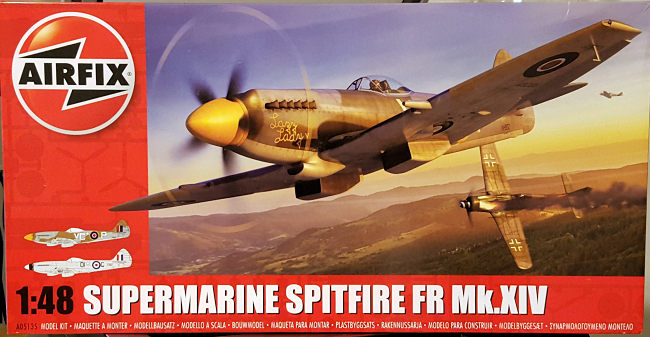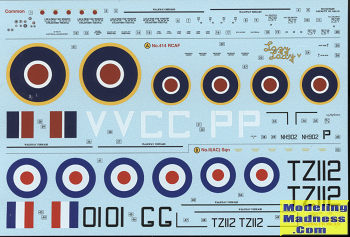
| KIT #: | A05135 |
| PRICE: | $20-30.00 |
| DECALS: | Two options |
| REVIEWER: | Scott Van Aken |
| NOTES: | 2019 tooling |

| HISTORY |
The first Griffon-powered Spitfires suffered from poor high altitude performance due to having only a single stage supercharged engine. By 1943, Rolls-Royce engineers had developed a new Griffon engine, the 61 series, with a two-stage supercharger. In the end it was a slightly modified engine, the 65 series, which was used in the Mk XIV. The resulting aircraft provided a substantial performance increase over the Mk IX. Although initially based on the Mk VIII airframe, common improvements made in aircraft produced later included the cut-back fuselage and tear-drop canopies, and the E-Type wing with improved armament.
The Mk XIV differed from the Mk XII in that the longer, two-stage supercharged Griffon 65, producing 2,050 hp (1,528 kW), was mounted 10 inches (25.4 cm) further forward. The top section of the engine bulkhead was angled forward, creating a distinctive change of angle to the upper cowling's rear edge. A new five bladed Rotol propeller of 10 ft 5 in (3.18 m) in diameter was used, although one prototype JF321 was fitted with a six bladed contra rotating unit. The "fishtail" design of ejector exhaust stub gave way to ones of circular section. The increased cooling requirements of the Griffon engine meant that all radiators were much bigger and the underwing housings were deeper than previous versions.
The cowling fasteners were new, flush fitting "Amal" type and there were more of them. The oil tank (which had been moved from the lower cowling location of the Merlin engine variants to forward of the fuselage fuel tanks) was increased in capacity from 6 to 10 gal.
To help balance the new engine, the radio equipment was moved further back in the rear fuselage and the access hatch was moved from the left fuselage side to the right. Better VHF radio equipment allowed for the aerial mast to be removed and replaced by a "whip" aerial further aft on the fuselage spine. Because the longer nose and the increased slipstream of the big five-bladed propeller a new tail unit with a taller, broader fin and a rudder of increased area was adopted.
The first production aircraft flew in October 1943 and by the time the 2nd TAF was deployed to Europe, six squadrons were operational by December 1944. As a note, these planes required 150 octane fuel, a luxury not afforded to their German counterparts who were still operating with 87 to 100 octane gasoline.
Late in 1944 a number of high-back full-span Mk XIVEs were converted by the Forward Repair Unit (FRU) to have a single camera fitted, facing to port or starboard; a conversion identical to that used on the FRU-converted FR Mk IXC. To achieve this a new hatch, similar to the radio hatch on the port side, was installed on the starboard side, and both hatches were fitted with camera ports in streamlined blisters. Otherwise this version of the FR Mk XIVE was essentially the same as the standard aircraft. These field-converted aircraft were allocated to 430 squadron RCAF. Later, purpose-built conversions, also known as the FR Mk XIVE, had the later cut-down rear fuselage with its tear drop–shaped canopy, port and/or starboard camera ports (without blisters), and an additional rear fuel tank of 34 gallons which extended the Spitfire's range to about 610 miles (980 km) on internal fuel. Because it was used mainly at low altitudes the "production" FR Mk XIVE had clipped wingtips.
In total, 957 Mk XIVs were built, over 430 of which were FR Mk XIVs. After the war, second hand Mk XIVs were exported to a number of foreign air forces; 132 went to the Royal Belgian Air Force, 70 went to the Royal Indian Air Force and 30 of its reconnaissance variant went to the Royal Thai Air Force.
| THE KIT |
The kit is standard fare for Airfix which means it is nicely molded and has somewhat softer plastic than you'll find from several other kit makers. This kit was produced in India, and while I did not see any issues with short shot pieces, that has been reported by many other modelers.
Airfix provides a cockpit module that includes the side walls, which is a nice option. You are also provided a pilot figure should you wish to use one. Airfix requires you to do some minor surgery on the fuselage depending on whether you want the canopy open or closed. You also have to trim a portion of the tip of the fin. The kit provides a separate entrance door which means you have to remove the one on the fuselage if you wish to utilize this option.
The only thing offered for under the aircraft is a centerline fuel tank and you'll need to open some holes for that. It is obvious that the lower wing is used for other kits as there are holes for rocket/bomb racks not used with this boxing. Since this is a clipped wing aircraft, you also need to remove the wing tips for which the stub replacements are provided.
Ailerons, elevators and rudders are separate with two rudder options being provided. If you do droop the elevators, keep in mind that it would be proper to reposition the control column a bit forward. Another option is to have the radiator exhaust flaps open up or down. When it comes to the landing gear, you are given yet another option and that is to have them raised or lowered. Airfix offers a display stand as an extra if you wish to model your kit in flight. Separate up and down gear doors are provided, which I like. A final option is different exhaust. This is all dependent on which of the kit markings options you use (as in the rudder as well). If using aftermarket decals, you need to do some research to have these bits correct.
 Instructions
are standard fare for Airfix with Humbrol paint numbers only provided during the
build. Two markings options are provided for you. One is the box art plane with
414 squadron at the end of the war. This one will have the smaller rudder and
the fishtail exhaust. The other is a post war plane in high speed silver with 2
Squadron. This one will have the broader rudder and the tubular exhaust. The
decal sheet is quite nicelly printed and should provide no issues. There are
also aftermarket sheets if you are so inclined.
Instructions
are standard fare for Airfix with Humbrol paint numbers only provided during the
build. Two markings options are provided for you. One is the box art plane with
414 squadron at the end of the war. This one will have the smaller rudder and
the fishtail exhaust. The other is a post war plane in high speed silver with 2
Squadron. This one will have the broader rudder and the tubular exhaust. The
decal sheet is quite nicelly printed and should provide no issues. There are
also aftermarket sheets if you are so inclined.
| CONCLUSIONS |
According to Tom Cleaver, who has built three of these, it is a fairly simple and trouble-free kit. Though this boxing is an FR.XIV, you can easily build and F.XIV or and F.XVIII with what comes in the box as there is little difference between them. I bought this one as I needed another kit to do a free shipping order and I didn't already have one. I'll add it to the growing stack of Airfix Spitfires and will hopefully get motivated to build a few of these in the near future.
| REFERENCES |
https://en.wikipedia.org/wiki/Supermarine_Spitfire_(Griffon-powered_variants)#Mk_XIV_(type_379)
May 2020
Copyright ModelingMadness.com. All rights reserved.
If you would like your product reviewed fairly and fairly quickly, please contact the editor or see other details in the Note to Contributors.
Back to the Main Page Back to the Review Index Page Back to the Previews Index Page